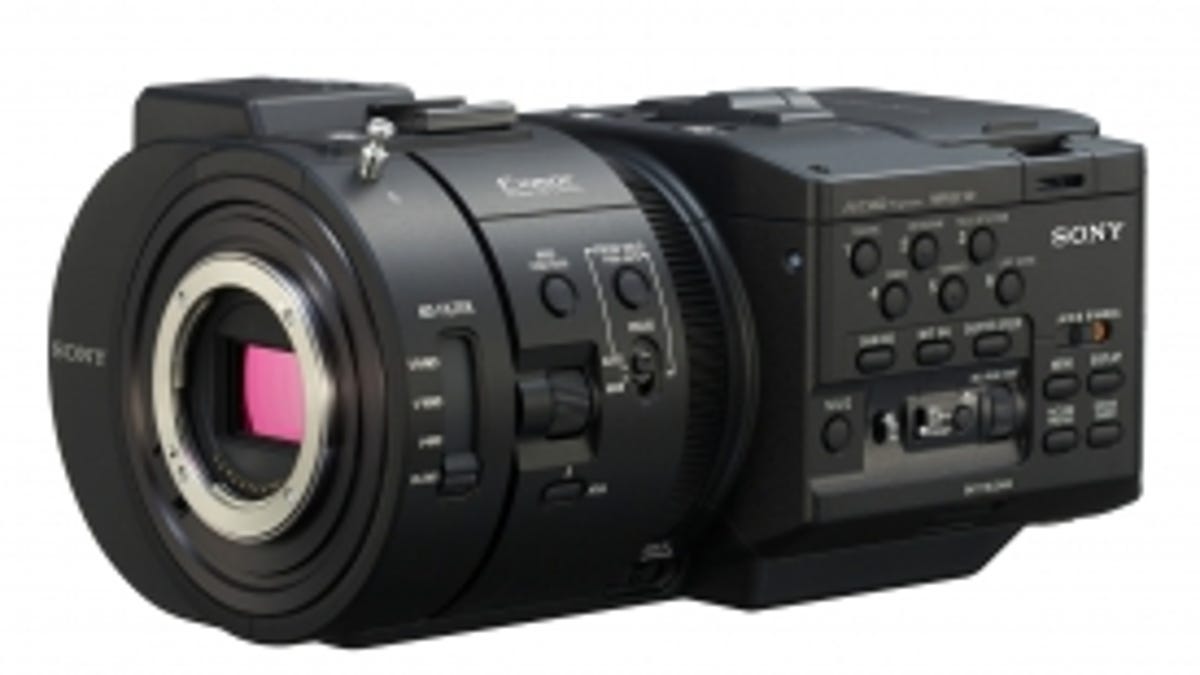NEX-FS700 pushes down Sony's 4K videocamera prices
The high-resolution videocamera is twice the price of JVC's 4K camera, though a lot cheaper than Sony's high-end earlier FS65. Still, not all 4K video is created equal.

Some folks satisfied with conventional 1080p video think the push to higher 4K resolution is silly -- but Sony execs are not on the list.
The company announced a new 4K videocamera today with interchangeable lenses, super-slow-motion options, and a Super 35mm-sized image sensor. Initially it'll shoot only conventional 1080p video, Sony said, but it's "4K-ready," meaning that with a planned firmware update it'll also be able to produce video imagery about 4,000 pixels wide.
Other high-end features include built-in 2-, 4-, and 6-stop neutral density filters, which can block light so videographers can shoot with wide apertures and therefore blurred-out backgrounds, and 3G-SDI output, which has enough capacity for high-end video formats, Sony said. The output will be able to keep up with 4K raw video, Sony said.
The videocamera (called the NEX-FS700U in the United States and the NEX-FS700E in Europe) is scheduled to ship in June for less than $10,000, including a 18-200mm lens. That's still not cheap, but it's a lot less expensive than its high-end F65 CineAlta, a 4K camera that went on sale last year for $65,000.
The camera can shoot slow-motion video at 5X and 10X speeds at 1080p resolution with 120fps and 240fps modes and 20X and 40X speeds at lower resolution with 480fps and 960fps modes, Sony said ahead of the National Association of Broadcasters conference that begins April 14.
As the NEX name indicates, the camera can use Sony's E-mount interchangeable lenses from its consumer-focused NEX cameras. Like them, it also can use an adapter to mount the higher-end A-mount lenses from its Alpha line of SLR and SLT cameras.
Given Sony's clout in this market, the camera should go down well with fans of 4K video. Most consumer TVs top out at 1080p, which at 1920x1080 pixels has roughly a quarter the resolution. Unless you're parked very close to the screen, appreciating the difference between 4K and 1080p can be challenge. Heck, plenty of people are happy streaming video and watching DVDs with resolution well below 1080p.
A big fan of 4K video is Red Camera, which has been promoting 4K video (and 5K, for that matter) as a way to shoot video today that will be able to keep up with display technology of tomorrow. In particular, Red is gunning for the cinema market.
JVC, too, has jumped aboard the 4K train with its $5,000 GY-HMQ10 announced in January.
But not all 4K is created equal. Indeed, it's worth reading this long piece on 4K by John Galt, senior vice president of advanced digital imaging at Panavision.
Galt points out that 4K originally meant an image 4,000 pixels wide -- but each pixel had red, green, and blue color information, which is not the case with typical 4K cameras you hear about today. They capture either red, green, or blue color information for each pixel, with image processing making its best guess about the full range of colors. He also observes that lenses and displays often can't keep up with the resolution demands. And that capturing full 4:4:4 color information and using a higher frame rate than cinema's 24fps also are important.
Perhaps he'd be pleased to hear of Canon's different approach than Sony's. After shaking up the videography and cinema business with its 5D Mark II SLR, it's now seriously targeting Hollywood with the $20,000 Canon C300 and a range of corresponding cine-specific lenses.
The lenses are good enough for 4K resolution, but the C300 is only 2K. Even though it has a 3,840x2,160-pixel sensor, it uses them to create full color data for each pixel or 1920x1080 video rather than interpolating.
Presumably this is related to Sony's initial approach with the NEX-FS700, which will get 4K video through interpolation.
Canon is headed for 4K, too -- perhaps as soon as the National Association of Broadcasters conference, where it could offer further detail on a planned 4K SLR that bears a strong resemblance to its flagship EOS-1D X. The camera uses Motion JPEG to encode the video, Canon said during the C300 announcement -- hardly a technology many videographers are excited about.
Perhaps that could change, though. Sony isn't the only company that can issue a firmware update.
(Via Cinescopophilia and EOS HD)

